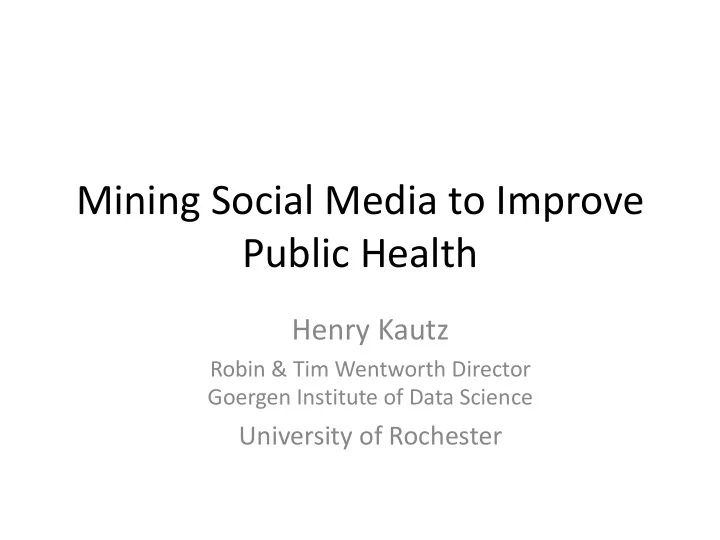

Mining Social Media to Improve Public Health Henry Kautz Robin & Tim Wentworth Director Goergen Institute of Data Science University of Rochester
People on Smartphones: An Organic Sensor Network Social media: • Population scale • No need to recruit subjects • Fine granularity • Timely Public health questions: • Who is likely to contract 24 Hour Heat Map of Tweets, NYC disease? • What lifestyle factors influence health? • What are sources of disease?
Twitterflu: Tracking Influenza • Public Twitter feeds can be mined for self- reports of flu symptoms – “sick tweets” • 2014: 5% of Tweets are tagged with GPS coordinates or specific locations
Analyzing Tweets • Goal: find tweets about disease symptoms Previous approach: keywords – Problems: “sick of homework”, “under the weather” – • Our approach: machine learning Use Mechanical Turk workers to train the system – 98% accuracy – Training Data Sick Contains Machine Tweets “sneeze”? Learning “sick”? System “tired”?
• Each trigram is a feature (dimension) • Support vector machine: find a hyperplane that separates positive from negative examples
sick +0.8 +0.8
sick and tired +0.7 +0.8 +0.6 -0.7
sick and tired of -0.1 +0.8 +0.6 -0.7 -0.8
sick and tired of flu +0.6 +0.8 +0.6 +0.7 -0.7 -0.8 How do we get these numbers???
Positive Features Negative Features Feature Weight Feature Weight ´ 0 . 4005 sick 0.9579 sick of headache 0.5249 you ´ 0 . 3662 flu 0.5051 lol ´ 0 . 3017 ´ 0 . 1753 fever 0.3879 love feel 0.3451 i feel your ´ 0 . 1416 coughing 0.2917 so sick of ´ 0 . 0887 ´ 0 . 1026 being sick 0.1919 bieber fever better 0.1988 smoking ´ 0 . 0980 being 0.1943 i’m sick of ´ 0 . 0894 ´ 0 . 0837 stomach 0.1703 pressure and my 0.1687 massage ´ 0 . 0726 ´ 0 . 0719 infection 0.1686 i love morning 0.1647 pregnant ´ 0 . 0639
Cascade SVM
Validating T f • NYC, Boston, Los Angeles, Seattle, San Francisco • T f correlated with C f (R=0.80, p=0.002) • T f correlated with G f (R=0.87, p=0.0002)
Impact of Co-Location
Impact of Friendships (Sadilek et al AAAI 2012)
Social Network Centrality Correlates with Health
Factors Influencing Health (Sadilek & Kautz WSDM 2013)
Disease Hubs & Vectors (Brenan et al IJCAI 2013)
The Data target users: tweeted from more than one airport
Volume and Sick Traveller Features • f(t, x→y) = # Twitter users who flew from airport x to airport y – User tweeted from x on day t – User tweeted from y earlier on day t or on day t-1 • V(t,x) = # Twitters users who flew into x on day t • f s (t, x→y) = # sick Twitter users who flew from from airport x to airport y – User made “sick” tweet on day t or t-1 • S(t,x) = # sick Twitters users who flew into x on day t
Meeting Feature • Two users assumed to meet if they appear within 100 meters of each other within one hour • M(t,x) = # meetings that users traveling to airport x on day t had with sick users on days t or t-1 • Captures number of exposed individuals traveling to x
Measuring Explanatory Power of Features • Goal: explain weekly change in Google Flu measure, ΔG f , in each city x • Linear regression over features from prior 7 days explains % of ΔG f features V(t, x) 56% V(t, x), S(t,x) 73% V(t, x), S(t,x), M(t,x) 78%
Prediction • Goal: predict T f for city x on a given day using V(x,t), S(x,t), M(x,t) for 3 previous days • Single linear regression model for all cities • Our prediction of a city's flu index next week is within 7% of the true value 95% of the time
GeoDrink • Understanding patterns of alcohol use in communities • Infer locations of users’ homes and the exact time and place of drinking
nEmesis: Foodborne Illness Surveillance
Foodborne Illness • Affects 48 million people annually in US • 128,000 hospitalizations • 3,000 deaths
Fighting Foodborne Illness • Primary tools – Education of general public – Inspections of food venues • Challenges – Food venues inspected yearly: can predict and prepare for inspection – Unlicensed venues • How can we target inspections more effectively? • Can we find problematic unlicensed venues?
nEmesis • Train algorithm to find self-reports of stomach ailments only • Link sick tweets to restaurants where user ate • Use information to target health inspections
Las Vegas Trial • 3 month trial by Southern Nevada Health District (Las Vegas), Jan-Mar 2015 • Venues with highest predicted risk flagged for inspection – Paired control venue also inspected – 71 adaptive / 71 control inspections – Inspectors blind to which are adaptive
Results • Adaptive inspections uncover more violations – 9 demerits vs 6 demerits (p = 0.019) – Significantly more “C grades” discovered: 11 vs 7 • Adaptive inspections estimated to prevent 71 infections and 4.4 hospitalizations during trial • nEmesis alerted health department to an unlicensed seafood venue
Summary • Previous work (by ourselves and others) showed that social media analysis could track and predict disease • This is the first study that shows an effective intervention based on social media analysis • CDC proposal under review to expand to a 3- year long study
Thanks • Great students Adam Sadilek, Tianran Hu, Nabil Hossain, Jack Teitel, Sean Brennan • Great colleagues Jiebo Luo (URCS), Chris Homan (RIT), Ann Marie White (URMC), Vince Silenzio (URMC), Lauren DiPrete (SNHD) • NSF and Intel
Recommend
More recommend